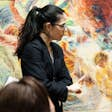Online course: Modern Art & Ideas (part of the Long term online programme: Modern and Contemporary Art and Design)
Dates: any time
Duration: 14 hours
Rating: 4.8 / 5.0 out of 5016 ratings (see top rating courses here)
Participating countries: any country
Apply here: Application form
Organizer: The Museum of Modern Art at Coursera
Cost:
- FREE
- $49 with sharable certificate
Modern Art & Ideas
Among all objects of design, our clothes are the most universal and intimate. Like other kinds of design, fashion thrives on productive tensions between form and function, automation and craftsmanship, standardization and customization, universality and self-expression, and pragmatism and utopian vision. It exists in the service of others, and it can have profound consequences—social, political, cultural, economic, and environmental.
Fashion as Design focuses on a selection of more than 70 garments and accessories from around the world, ranging from kente cloth to jeans to 3D-printed dresses. Through these garments, we’re going to look closely at what we wear, why we wear it, how it’s made, and what it means. You’ll hear directly from a range of designers, makers, historians, and others working with clothing every day—and, in some cases, reinventing it for the future. Studio visits, interviews, and other resources introduce the history and development of each garment and their changing uses, meanings, and impact over time. Course Learning Objectives: Develop critical tools to appreciate and contextualize fashion design—from everyday clothing to couture garments—through many different perspectives. Trace the history, development, and impact of garments over time, and explore how they may be reinvented. Investigate garments through multiple lenses including politics, identity, and economics. Understand more about the lifecycle of clothing, from its design and production to its marketing, distribution, and consumption. Better comprehend the choices you make about fashion with respect to the visual language of dress, individual and collective identities, and issues such as labor practices, sustainability, and body politics.
Instructor

Lisa Mazzola
Assistant Director, School and Teacher Programs
Department of Education
Programme
WEEK 1: 1 hour to complete
Module 1: Introduction to Modern Art & Ideas
Be introduced to some of the overall benefits of studying modern and contemporary art through accessible and relevant themes.
Introduction to Modern Art & Ideas
Welcome to the Course!
What is Modern Art?
Suggestions for Making the Most of the Course
Resources: MoMA podcasts, art vocabulary, Magazine, and YouTube channel
Tell Us About You
WEEK 2: 3 hours to complete
Module 2: Places & Spaces
Discover some of the many ways that artists represent place and take inspiration from their environment.
Places & Spaces
Vincent van Gogh. The Starry Night. 1889
Piet Mondrian. Broadway Boogie Woogie. 1942–43
Gordon Matta-Clark. Bingo. 1974
Norman Lewis. City Night. 1949
Andrew Wyeth. Christina’s World. 1948
Salvador Dalí. The Persistence of Memory. 1931
Claude Monet. Water Lilies. 1914–26
Rachel Whiteread. Water Tower. 1998
Edward Hopper. House By the Railroad. 1925
Louis I. Kahn. Sher-e-Bangla Nagar, Capital of Bangladesh, Dhaka, Bangladesh (Study for National Assembly Building). 1962–83
Zarina. Home is a Foreign Place. 1999
Introduction to Places & Spaces
In Depth: Bernd & Hilla Becher
WEEK 3: 2 hours to complete
Module 3: Art & Identity
See how artists create works of art to express, explore, and question identity.
Art & Identity
Frida Kahlo. Self-Portait with Cropped Hair. 1940
Andy Warhol. Gold Marilyn Monroe. 1962
Pablo Picasso. Girl before a Mirror. 1932
Marc Chagall. I and the Village. 1911
Henri Matisse. The Red Studio. 1911
Rineke Dijkstra. Almerisa series. 1994–2008
Kara Walker. 40 Acres of Mules. 2015
In Depth: Frida Kahlo and Ellen Gallagher10m
WEEK 4: 2 hours to complete
Module 4: Transforming Everyday Objects
Discover how artists use everyday objects to challenge assumptions about what constitutes art and how it should be made. Explore a variety of artistic and design choices, and the creative acts of inventing and transforming everyday objects.
Transforming Everyday Objects
Marcel Duchamp. Bicycle Wheel. 1913
Robert Rauschenberg. Bed. 1955
Meret Oppenheim. Object. 1936
Décolletage Plastique Design Team. Bic Cristal® Ballpoint pen. 1950
Louise Nevelson. Sky Cathedral. 1958
Mike Kelley. Untitled. 1990
Jessica Rosenkrantz, Jesse Louis-Rosenberg. Kinematics Dress. 2013
Doris Salcedo. Atrabilious. 1992–93
Betye Saar. Black Girl’s Window. 1969
Introduction to Transforming Everyday Objects
In Depth: Design Objects & Marcel Duchamp
WEEK 5: 2 hours to complete
Module 5: Art & Society
Explore works of art created in response to the social, cultural, and political issues of their time. Gain a deeper understanding of history and contemporary society. Be encouraged to think critically about world events and how they are depicted.
Art & Society
Dorothea Lange. Migrant Mother. 1936
Jacob Lawrence. Migration Series. 1940–41
Martha Rosler. House Beautiful (Bringing the War Home). 1967–72
Jasper Johns. Flag. 1954–55
Shahzia Sikander. Candied. 2003
Faith Ringgold. American People Series #20: Die. 1967
Beatriz González. Zócalo de la comedia, and Zócalo de la tragedia. 1983.
In Depth: Spatial Information Design Lab & Jasper Johns
Long term online programme: Modern and Contemporary Art and Design
This course is part of the Long term online programme: Modern and Contemporary Art and Design.
| Name of the course | Category | Educator | Price | Duration (hours) | Score | Number of ratings |
| Fashion as Design |
Fashion, Design, History
|
FREE | 20 | 4.8 | 2302 | |
| Modern Art & Ideas |
Fashion, Design, History, Art
|
FREE | 14 | 4.8 | 5016 | |
| Seeing Through Photographs |
Fashion, Design, History, Photography
|
FREE | 17 | 4.8 | 3670 | |
| What Is Contemporary Art? |
Fashion, Design, History, Art
|
FREE | 12 | 4.7 | 1376 |
Leave a Reply